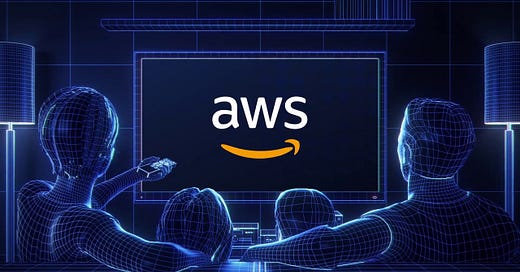Last year, AWS surpassed the $100 billion revenue mark! It is easy to see success in hindsight, but the creation of Amazon Web Services (AWS) within Amazon is nothing short of a miracle. AWS, Azure, and Google Cloud are like unregulated utility companies that leverage the internet.
In this article, you will learn why the creation of AWS within Amazon is so special, why incentives played a crucial role, and how AWS disrupted the (seemingly) impenetrable moat of Oracle and IBM.
Before we start, let’s look at the growth of AWS in recent years:
It’s a thing of beauty, isn’t it? This is compounding at its core. And if you ask us, investors still undervalue the strength of AWS, its moat, and the limitless runway it has.
"Your margin is my opportunity"
Before Amazon created AWS (and with it, the ‘cloud’) companies had to physically store their data. IBM and Oracle owned this highly profitable market. They obligated companies to purchase service packages, which earned the legacy players a gross profit margins of around 80%.
This 80% margin was the opportunity Amazon used to disrupt the market. In hindsight, it makes sense that Oracle and IBM missed the boat on cloud computing. Why would they willingly trade their highly profitable, and seemingly durable business model for one that only results in gross margins of 20% - 40%? This is the ‘counter-positioning’ moat in action. IBM and Oracle would need to cannibalize their own, highly profitable business model, while Amazon could offer a superior cheaper product.
For Amazon, the 20-40% margins IBM and Oracle were getting, looked wonderful. Especially compared to its e-commerce division, where margins were in the single digits when AWS was created. Cloud margins were pure gold.
Given that the potential is high enough, it is all about perspective. It also shows us how rare it is for a company to cannibalize its own business to succeed in the long-term success. Only a rare breed of visionaries was able to do this. These visionaries are almost exclusively founders.
Incentives matter
The secret behind the creation of AWS was Amazon’s incentive structure. Amazon ties bonuses to one single criterion: its stock price.
For most companies, we do not think this incentive structure is a good idea, since executives have no direct control over share prices, which could lead to short-term decision-making. (I bet Airbnb’s CEO is kicking himself by now.)
But if you want to be the most innovative company in the world, one that spawns money machines like AWS, Prime, and Kindle, then this incentive structure is the only right one.
Do you think a manager incentivized by the number of newly introduced product categories would have ever pitched AWS? Very unlikely.
Penetrating an "Impenetrable" Moat
The fact that Amazon itself only got rid of its Oracle databases in 2019 speaks volumes about the strength of Oracle and IBM’s moat (switching costs).
Back in 2012, when AWS needed to convince other companies with traditional IT infrastructure to switch, Andy Jassy gave six key reasons why they should choose AWS over physical infrastructure:
Capital expenses are replaced with operational expenses.
Lower operational costs due to economies of scale.
No need to estimate future IT capacity, AWS is elastic.
Ability to scale down (which was nearly impossible with legacy providers).
Software engineers can focus on coding instead of managing infrastructure.
Companies gain flexibility since they no longer rely on physical servers.
Reading these six reasons, it's no surprise that today, around 60% of the world’s business data is stored in the cloud. And this trend is likely to keep growing for, who knows how long…
"It is still early days for the cloud." - Andy Jassy (2020)
Hopefully, this article has shared our appreciation for AWS’s creation with you. You know now that high margins can attract competition, why incentives are so important, and that it takes a superior product to revolutionize an industry.
We can consider ourselves lucky to witness how AWS and the cloud market evolve in the coming years.
Have a wonderful day and happy investing.
The Dutch Investors
If you haven't subscribed yet, don’t forget to do so below:







Believe this is worth your time reviewing -https://open.substack.com/pub/moiglobal/p/are-the-hyperscalers-turning-themselves?utm_source=share&utm_medium=android&r=298ptd